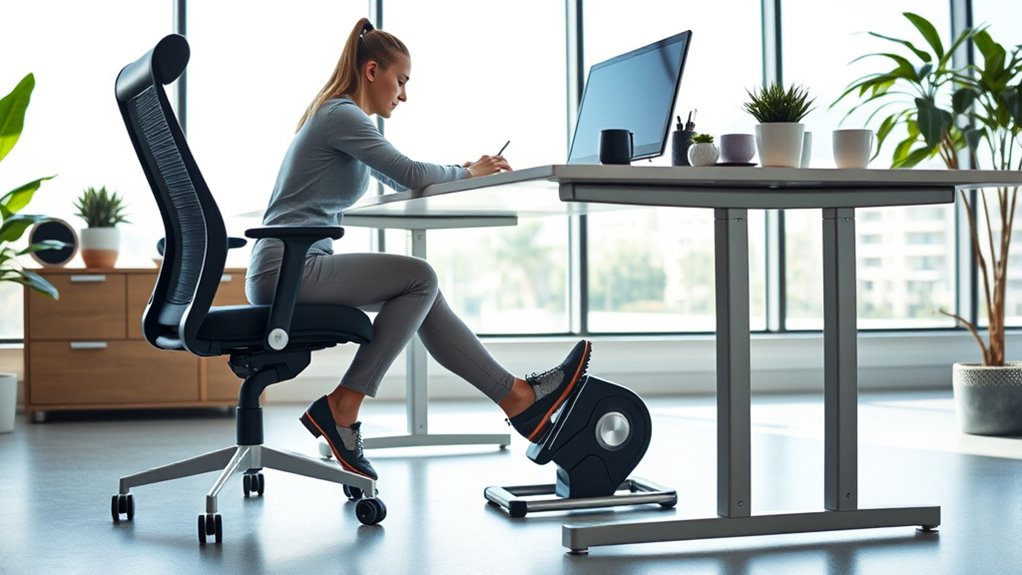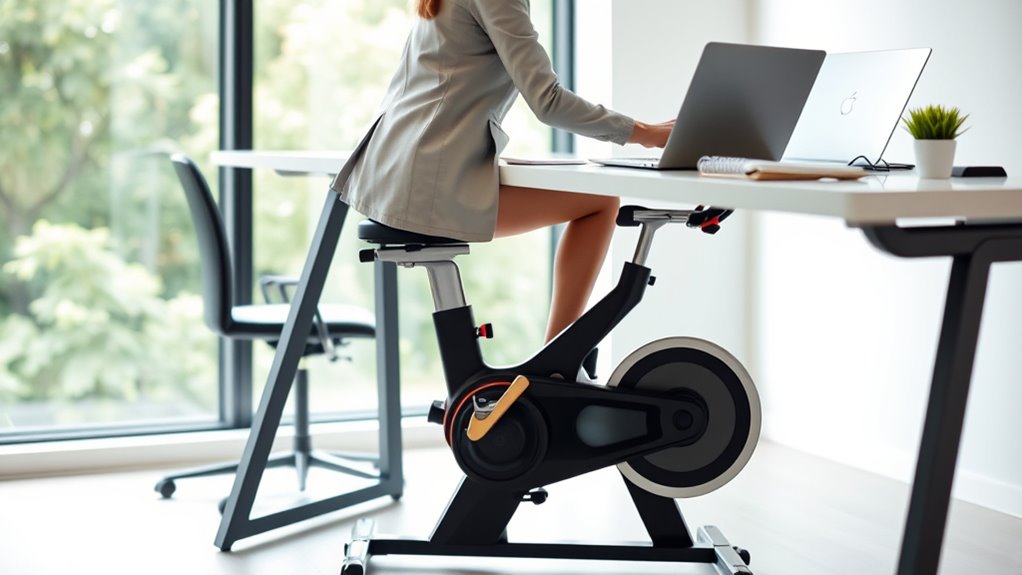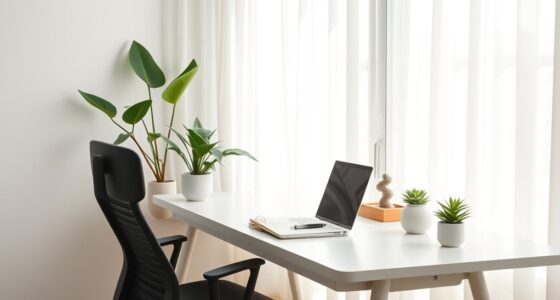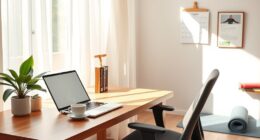To stay active while working, incorporate simple under-desk exercises like leg lifts, ankle rotations, or using a compact pedal exerciser. Combine these moves with ergonomic accessories such as a supportive footrest or adjustable sit-stand desk to promote movement and improve posture. Take short breaks for stretches like reaching for your toes or shoulder rolls to relieve tension. Keep these practices consistent, and you’ll find how small actions can boost your energy and overall health—learn more about effective strategies below.
Key Takeaways
- Use compact pedal exercisers under your desk to promote movement without disrupting workflow.
- Incorporate regular stretching routines, like arm overhead stretches and shoulder rolls, during breaks.
- Set hourly reminders for light activity, such as leg lifts or standing, to counteract prolonged sitting.
- Adjust your sit-stand desk to alternate between sitting and standing, encouraging movement throughout the day.
- Combine ergonomic accessories with stretching to improve posture, reduce strain, and maintain overall activity.

If you spend long hours at a desk, incorporating under-desk exercise can be a simple way to stay active without disrupting your workflow. The key is to use ergonomic accessories that make movement comfortable and safe. For example, a compact pedal exerciser placed under your desk allows you to pedal discreetly while working on emails or reports. These devices are designed to fit seamlessly into your workspace, helping you burn calories and improve circulation without needing extra space. With the right ergonomic accessories, you can turn your workspace into an active zone, reducing the sedentary habits that come with prolonged sitting.
Office stretching is another effective method to incorporate movement into your day. You can perform simple stretches right at your desk to relieve tension and improve flexibility. Stretch your arms overhead, roll your shoulders, or reach for your toes to activate different muscle groups. These movements don’t require special equipment and can be done quickly between tasks or during breaks. Combining office stretching with under-desk exercises creates a balanced approach to staying active, especially if you’re limited on time or space.
To maximize the benefits, consider setting a regular schedule for these exercises. For instance, do a few minutes of leg lifts or ankle rotations every hour. Using ergonomic accessories like a footrest can support your legs during these exercises, making them more comfortable and effective. You might also find that adjustable sit-stand desks encourage movement, enabling you to alternate between sitting and standing, which naturally prompts you to incorporate more office stretching and light activity.
Remember, movement habits are crucial for counteracting the negative effects of prolonged sitting. Even small movements, performed regularly, can make a big difference in your overall activity level. Keep in mind that ergonomic accessories aren’t just about comfort—they’re about promoting better posture and reducing strain, which can enhance your ability to move freely. When you combine these tools with office stretching routines, you create a habit of movement that counters the negative effects of prolonged sitting.
Incorporating under-desk exercise into your daily routine doesn’t mean major overhauls or complex workouts. It’s about smart, manageable steps—using ergonomic accessories to facilitate movement and integrating simple office stretching into your day. Over time, these small efforts add up, helping you stay active, reduce discomfort, and boost your productivity. By making movement a natural part of your workday, you’ll feel more energized and healthier, all while maintaining your focus on your tasks.
Frequently Asked Questions
Can Under-Desk Exercises Replace Regular Workouts Effectively?
Under-desk exercises can’t fully replace regular workouts, but they do offer useful benefits. They help you stay active during the day, providing some cardio benefits and muscle strengthening. While they’re great for breaking up long periods of sitting, you’ll need more intense routines for overall fitness. Incorporating these exercises into your daily routine supports your health, but don’t rely on them alone for all-encompassing fitness and cardio benefits.
Are There Any Safety Concerns With Under-Desk Exercises?
You might worry about slip hazards or ergonomic issues with under-desk exercises. While they’re generally safe, you should keep the area clear to prevent slips, especially on smooth floors. Make ergonomic adjustments to your workspace to avoid strain. Always start slowly, listen to your body, and stop if you feel discomfort. With proper setup and caution, under-desk exercises can be safe and beneficial during your workday.
What Equipment Is Needed for Effective Under-Desk Workouts?
For effective under-desk workouts, you mainly need portable mats and resistance bands. The portable mats provide a comfortable surface to sit or kneel on, while resistance bands add variety and resistance for your exercises. You can easily store them under your desk and use them during breaks. These simple tools make it easy to stay active without any complicated equipment, helping you maintain your fitness throughout the workday.
How Often Should I Perform Under-Desk Exercises During Work Hours?
Imagine your muscles awakening as you sit at your desk, engaging with every movement. You should perform under-desk exercises every 30 to 60 minutes, keeping your ergonomic benefits in mind. Regular movement boosts circulation, relieves tension, and enhances muscle engagement. Break up your workday with these quick exercises, ensuring you stay energized and comfortable, preventing stiffness and fatigue while maintaining productivity and overall well-being.
Can Under-Desk Exercises Help Improve Posture and Reduce Back Pain?
Under-desk exercises can definitely help improve your posture and reduce back pain. By integrating stretching routines and adjusting your ergonomic chair properly, you keep your muscles active and support good alignment. These small movements prevent stiffness and strain, especially during long work hours. Consistently combining ergonomic chair adjustments with targeted under-desk exercises keeps your back healthier and encourages better posture throughout the day.
Conclusion
Staying active at work is like tending a garden—you need to nurture it daily. Incorporating under-desk exercises keeps your body moving and your mind sharp, preventing the sedentary slump from taking root. Remember, small steps can make waves, transforming your routine from stagnant to lively. So, keep the momentum going—your health blossoms when you make movement a daily habit. After all, a little effort now plants the seeds for a healthier, happier you.









